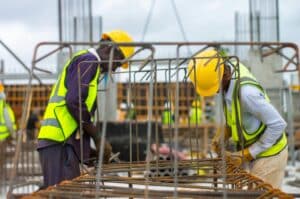Respirator protection is an essential line of defense in industrial settings. From wood dust at construction sites to chemical fumes in industrial settings, choosing the right PPE is critical for employee health.
In this article, we’ll help you break down the options, so you can make an informed choice when choosing the best respirator protection for you.
Understanding Respirator Ratings
Respirator ratings, such as N95 or P100, indicate their filtration efficiency. An N95 respirator filters 95% of airborne particles and is optimal for non-oil based particulates, while a P100 respirator filters at least 99.97%, making it capable of handling oil-based aerosols.
Your choice should be informed by the specific types of particulates present in your workplace.
Oil Resistance: N vs. P Series
The ‘N’ in N95 indicates that the respirator is not oil-resistant, making it suitable for environments free of oil particulates. On the other hand, the ‘P’ in P100 indicates its efficacy in oil-present atmospheres. During the COVID-19 pandemic, N95 respirators were extensively used to protect against virus transmission through non-oil based aerosols.
Understanding the presence or absence of oil particulates in your environment, based on hazard assessment or air sampling data, is essential when selecting a respirator.
5 Types of Respirator Protection
- Particulate Respirators: Typically disposable, these are used for protection against dust and mists. N95 respirators are a common example you’ll see on a construction site.
- Powered Air-Purifying Respirators (PAPRs): Utilizing a battery-powered blower to filter air, these respirators offer enhanced protection and are particularly useful if you have facial hair.
- Air-Purifying Respirators (APRs): Available in half-face and full-face versions, APRs protect against particulates, gases, and vapors. They rely on a tight seal and selection of the appropriate cartridge to function properly.
- Self-Contained Breathing Apparatus (SCBA): These respirators are essential in extremely hazardous environments and provide clean air from a tank. If you atmosphere is classified as “Immediately Dangerous to Life or Health (IDLH)” (such as in a confined space), SCBA respirators are required.
- Supplied Air Respirators: For long-duration jobs, these provide a continuous air supply from an external source, and like SCBAs, they are often used in IDLH atmospheres.
Selecting the Right Respirator
Choosing the right respirator means understanding the specific hazards and conditions of your work environment. In low oxygen areas, SCBAs or supplied air respirators are necessary. Where oxygen is sufficient but respiratory hazards from particulates or chemicals exist, the right APRs with suitable filters are needed. Ensuring that the hazard has been accurately identified (and quantified) is vital in choosing the most effective respirator.
For dust-related tasks, an N95 might be enough, but for toxic substances, a more comprehensive solution like a full-face APR or PAPR is recommended.
Following Safety Standards and Guidelines
Adhering to the safety standards set by the Occupational Safety and Health Administration (OSHA) is not only a legal requirement but also a fundamental component of ensuring worker safety.
These guidelines are key for the proper selection, use, and maintenance of respirators, safeguarding against respiratory health risks.
Partner with Exceed Safety for Expert Guidance
Securing proper respiratory protection is a crucial step in workplace safety. At Exceed Safety, we specialize in guiding companies through the complexities of OSHA compliance and nurturing a proactive safety culture. With our tailored training programs and detailed safety audits, we don’t just meet standards; we set them.
Ready to transform your safety practices? Contact Exceed Safety for expert training services that empower and protect your workforce. Visit our website to begin your journey toward a safer, more secure workplace.
UPDATE 4/2024: This post has been updated for comprehension and clarity.
Building Safety from the Start with Prevention Through Design
In workplace safety, the best results come from stopping hazards before they ever reach employees. While training, procedures, and personal protective equipment (PPE) are important, the most effective approach is to design hazards out of the workplace from the beginning. This approach is known as Prevention through Design (PtD). What is Prevention through Design? Prevention…
Continue Reading Building Safety from the Start with Prevention Through Design
Emergency Preparedness: Staying Ready
Whether a misstep causes a fall or a natural disaster causes an evacuation, emergencies happen. Emergency preparedness and response can mean the difference in avoiding an injury or ending with a fatality. Emergencies come with little to no warning. While we may think these are extreme situations that will “never” happen to us, the reality…
Continuous Improvement and Immersive Training in Action
Construction is a dangerous business. Risks are constant, standards shift, and complacency can be deadly. For Jennifer Lastra, a U.S. Navy veteran and current CEO of 360 Immersive, corporate-style training falls far short. True safety begins with continuous improvement, supported by real engagement on the job. Training Should Go Beyond a Click-Through Box “Corporate training…
Continue Reading Continuous Improvement and Immersive Training in Action











